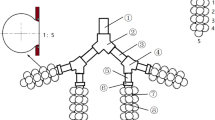Abstract
In an effort to determine the mechanism of papain action in causing an emphysema-like lesion in hamsters, the number and types of cells and the activities of two lysosomal enzymes in the lung were determined after papain exposure. Three and four weeks after a 3-h exposure to an aerosol of 3% papain the following alterations in lung structure and function were observed: (1) the mean linear intercept, or average distance between adjacent alveoli, was increased; (2) the internal surface area declined; (3) the dynamic compliance was elevated at low breathing frequencies. The numbers of cells present free in the lung increased from a control value of 2.0±0.2×106 to 6.6±0.5×106 5 days after exposure. The freeβ-glucuronidase, a lysosomal enzyme, likewise increased over threefold during the first 3 days after exposure. These results are consistent with the hypothesis that papain induces an inflammatory-type response, and this may be in part responsible for inducing the lesion.
Similar content being viewed by others
References
Kueppers, F., andA.G. Bearn. 1966. A possible experimental approach to the association of hereditaryα 1-antitrypsin deficiency and pulmonary emphysema.Proc. Soc. Exp. Biol. Med. 121:1207.
Lieberman, J., andM.A. Gawad. 1971. Inhibitors of leukocytic proteases in purulent sputum.J. Lab. Clin. Med. 77:713.
Martin, R.R. 1973. Altered morphology and increased acid hydrolase content of pulmonary macrophages from cigarette smokers.Am. Rev. Resp. Dis. 107:596.
Kilburn, K.H., A.R. Dowell, andP.C. Pratt. 1971. Morphological and biochemical assessment of papain-induced emphysema.Arch. Intern. Med. 127:885.
Hayes, J.A., A. Korthy, andG.L. Snider. 1975. The pathology of elastase-induced panacinar emphysema in hamsters.J. Pathol. 171:1.
Martorana, P.A., J.W. Richard, N.W. McKeel, andN.N. Share. 1975.α 1-Antitrypsin: Effect on total free lung cells at doses preventing experimental emphysema.Am. Rev. Resp. Dis. 111, 918.
Colombo, C., andE.G. Steinetz. 1975. Lung enzymes in emphysematous rats: Effects of progestagens, antiphlogistics and metabolic inhibitors.Arch. Int. Pharmacodyn.216:86.
Giles, R.E., M.P. Finkel, andJ. Mazurowski. 1971. Use of an analog on-line computer for the evaluation of pulmonary resistance and dynamic compliance in the anesthetized dog.Arch. Int. Pharmacodyn.194:213.
Gil, J. 1971. Ultrastructure of lung fixed under physiologically defined conditions.Arch. Intern. Med. 127:896.
Weibel, E.R. 1971. Morphometry of the Human Lung. Archive Press, New York. pp. 10–39.
Fishman, W.M., B. Springer, andR. Brunetti. 1948. Application of an improved glucuronidase assay method to the study of human bloodβ-glucuronidase.J. Biol. Chem. 173:449.
Roy, A.B. 1960. The synthesis and hydrolysis of sulfate esters.Adv. Enzymol. 22:205.
Macklem, P.T. 1973. The pathophysiology of chronic bronchitis and emphysema.Med. Clin. North Am. 57:669.
Martin, R.R., D. Lindsay, P. Despas, D. Bruce, M. Lerous, N.R. Anthonisen, andP.T. Macklem. 1975. The early detection of airway obstruction.Am. Rev. Resp. Dis. 111:119.
Martorana, P.A., N.W. McKeel, J.W. Richard, andN.N. Share. 1973. Function-structure correlation studies on excised hamster lungs in papain-induced emphysema.Can. J. Physiol. Pharmacol. 51:635.
Niewoehner, D.E., andJ. Kleinerman. 1973. Effects of experimental emphysema and bronchiolitis on lung mechanics and morphometry.J. Appl. Physiol. 35:25.
Snider, G.L., J.A. Hayes, C. Franzblau, H.M. Kagan, P.S. Stone, andA.L. Korthy. 1974. Relationship between elastolytic activity and experimental emphysema-inducing properties of papain preparations.Am. Rev. Resp. Dis. 110:254.
Blackwood, C.E., Y. Hosannah, E. Perman, S. Keller, andI. Mandl. 1973. Experimental emphysema in rats: Elastolytic titer of inducing enzyme as determinants of the response.Proc. Soc. Exp. Biol. Med. 144:450.
Johanson, W.G., R.C. Reynolds, T.C. Scott, andA.K. Pierce. 1973. Connective tissue damage in emphysema.Am. Rev. Resp. Dis. 107:589.
Martorana, P.A., J.W. Richard, N.W. McKeel, andN.N. Share. 1974. Inhibition of papain-induced emphysema in the hamster by humanα 1-antitrypsin.Can. J. Physiol. Pharmacol. 54:758.
Harris, J.O., G.N. Olsen, J.R. Castle, andA.S. Maloney. 1975. Comparison of proteolytic enzyme activity in pulmonary alveolar macrophages and blood leukocytes in smokers and nonsmokers.Am. Rev. Resp. Dis. 111:579.
Bretz, U., andM. Baggiolini. 1974. Biochemical and morphological characterization of azurophil and specific granules of human neutrophilic polymorphonuclear leukocytes.J. Cell Biol. 63:251.
Smith, C., andD. Hamerman. 1962. Acid phosphatase in human synovial fluid.Arthritis Rheum. 5:411.
Caygill, J.C., andD.A. Pitkeathly. 1966. A study ofβ-acetylglucosaminidase and acid phosphatase in pathological joint fluids.Ann. Rheum. Dis. 25:137.
Jasani, M.K., M. Katori, andG.P. Lewis. 1969. Intracellular enzymes and kinin enzymes in synovial fluid in joint disease.Rheum. Dis. 28:497.
Waxman, B.A., andC.B. Sledge. 1973. Correlation of histochemical, histologic and biochemical evaluations of human synovium with clinical activity.Arthritis Rheum. 16:376.
Krane, S.M. 1975. Collagenase production by human synovial tissue.Ann. N. Y. Acad. Sci. 256:289.
Author information
Authors and Affiliations
Rights and permissions
About this article
Cite this article
Ackerman, N.R., Corkey, R. & Perkins, D. Pathogenesis of papain-induced emphysema in the hamster. Inflammation 3, 49–58 (1978). https://doi.org/10.1007/BF00917321
Issue Date:
DOI: https://doi.org/10.1007/BF00917321




